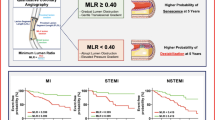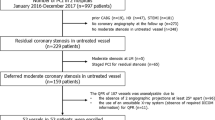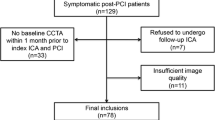Abstract
Studies have shown that the quantitative flow ratio (QFR), recently introduced to assess lesion severity from coronary angiography, provides useful prognostic information; however the additive value of this technique over intravascular imaging in detecting lesions that are likely to cause events is yet unclear. We analysed data acquired in the PROSPECT and IBIS-4 studies, in particular the baseline virtual histology-intravascular ultrasound (VH-IVUS) and angiographic data from 17 non-culprit lesions with a presumable vulnerable phenotype (i.e., thin or thick cap fibroatheroma) that caused major adverse cardiac events or required revascularization (MACE) at 5-year follow-up and from a group of 78 vulnerable plaques that remained quiescent. The segments studied by VH-IVUS were identified in coronary angiography and the QFR was estimated. The additive value of 3-dimensional quantitative coronary angiography (3D-QCA) and of the QFR in predicting MACE at 5 year follow-up beyond plaque characteristics was examined. It was found that MACE lesions had a greater plaque burden (PB) and smaller minimum lumen area (MLA) on VH-IVUS, a longer length and a smaller minimum lumen diameter (MLD) on 3D-QCA and a lower QFR compared with lesions that remained quiescent. By univariate analysis MLA, PB, MLD, lesion length on 3D-QCA and QFR were predictors of MACE. In multivariate analysis a low but normal QFR (> 0.80 to < 0.97) was the only independent prediction of MACE (HR 3.53, 95% CI 1.16–10.75; P = 0.027). In non-flow limiting lesions with a vulnerable phenotype, QFR may provide additional prognostic information beyond plaque morphology for predicting MACE throughout 5 years.



Similar content being viewed by others
References
Park J, Lee JM, Koo BK et al (2018) Clinical relevance of functionally insignificant moderate coronary artery stenosis assessed by 3-vessel fractional flow reserve measurement. J Am Heart Assoc. https://doi.org/10.1161/JAHA.117.008055
Ahmed N, Layland J, Carrick D et al (2016) Safety of guidewire-based measurement of fractional flow reserve and the index of microvascular resistance using intravenous adenosine in patients with acute or recent myocardial infarction. Int J Cardiol. https://doi.org/10.1016/j.ijcard.2015.09.014
Tu S, Westra J, Yang J et al (2016) Diagnostic accuracy of fast computational approaches to derive fractional flow reserve from diagnostic coronary angiography: the international multicenter FAVOR Pilot Study. JACC Cardiovasc Interv. https://doi.org/10.1016/j.jcin.2016.07.013
Westra J, Andersen BK, Campo G et al (2018) Diagnostic performance of in-procedure angiography-derived quantitative flow reserve compared to pressure-derived fractional flow reserve: the FAVOR II Europe-Japan Study. J Am Heart Assoc. https://doi.org/10.1161/JAHA.118.009603
Xu B, Tu S, Qiao S et al (2017) Diagnostic accuracy of angiography-based quantitative flow ratio measurements for online assessment of coronary stenosis. J Am Coll Cardiol. https://doi.org/10.1016/j.jacc.2017.10.035
Hamaya R, Hoshino M, Kanno Y et al (2019) Prognostic implication of three-vessel contrast-flow quantitative flow ratio in patients with stable coronary artery disease. EuroIntervention 15:180–188. https://doi.org/10.4244/EIJ-D-18-00896
Tu S, Westra J, Adjedj J et al (2019) Fractional flow reserve in clinical practice: from wire-based invasive measurement to image-based computation. Eur Heart J. https://doi.org/10.1093/eurheartj/ehz918
Lee JM, Choi G, Koo BK et al (2018) Identification of high-risk plaques destined to cause acute coronary syndrome using coronary computed tomographic angiography and computational fluid dynamics. JACC Cardiovasc Imaging. https://doi.org/10.1016/j.jcmg.2018.01.023
Stone GW, Maehara A, Lansky AJ et al (2011) A prospective Natural-History Study of coronary atherosclerosis. N Engl J Med. https://doi.org/10.1056/NEJMoa1002358
Räber L, Taniwaki M, Zaugg S et al (2015) Effect of high-intensity statin therapy on atherosclerosis in non-infarct-related coronary arteries (IBIS-4): a serial intravascular ultrasonography study. Eur Heart J 36:490–500. https://doi.org/10.1093/eurheartj/ehu373
Stone PH, Maehara A, Coskun AU et al (2018) Role of low endothelial shear stress and plaque characteristics in the prediction of nonculprit major adverse cardiac events: the PROSPECT Study. JACC Cardiovasc Imaging. https://doi.org/10.1016/j.jcmg.2017.01.031
García-García HM, Mintz GS, Lerman A et al (2009) Tissue characterisation using intravascular radiofrequency data analysis: Recommendations for acquisition, analysis, interpretation and reporting. EuroIntervention. https://doi.org/10.4244/EIJV5I2A29
Tu S, Huang Z, Koning G et al (2010) A novel three-dimensional quantitative coronary angiography system: In-vivo comparison with intravascular ultrasound for assessing arterial segment length. Catheter Cardiovasc Interv. https://doi.org/10.1002/ccd.22502
Calvert PA, Obaid DR, O’Sullivan M et al (2011) Association between IVUS findings and adverse outcomes in patients with coronary artery disease: the VIVA (VH-IVUS in vulnerable atherosclerosis) study. JACC Cardiovasc Imaging. https://doi.org/10.1016/j.jcmg.2011.05.005
Waksman R (2018) Assessment of coronary near-infrared spectroscopy imaging to detect vulnerable plaques and vulnerable patients. The Lipid-Rich Plaque study. San Diego, pp 21–25
Prati F, Romagnoli E, Gatto L et al (2018) Relationship between OCT coronary plaque morphology and clinical outcome (CLIMA). In: EuroPCR, Paris
Johnson TW, Räber L, di Mario C et al (2019) Clinical use of intracoronary imaging. Part 2: acute coronary syndromes, ambiguous coronary angiography findings, and guiding interventional decision-making: an expert consensus document of the European Association of Percutaneous Cardiovascular Intervent. Eur Heart J. https://doi.org/10.1093/eurheartj/ehz332
Papafaklis MI, Mizuno S, Takahashi S et al (2016) Incremental predictive value of combined endothelial shear stress, plaque necrotic core, and plaque burden for future cardiac events: a post-hoc analysis of the PREDICTION Study. Int J Cardiol. https://doi.org/10.1016/j.ijcard.2015.08.208
Barbato E, Toth GG, Johnson NP et al (2016) A prospective Natural History Study of Coronary atherosclerosis using fractional flow reserve. J Am Coll Cardiol. https://doi.org/10.1016/j.jacc.2016.08.055
Johnson NP, Tóth GG, Lai D et al (2014) Prognostic value of fractional flow reserve: linking physiologic severity to clinical outcomes. J Am Coll Cardiol. https://doi.org/10.1016/j.jacc.2014.07.973
Spitaleri G, Tebaldi M, Biscaglia S et al (2018) Quantitative flow ratio identifies Nonculprit Coronary lesions requiring revascularization in patients with ST-segment-elevation myocardial infarction and multivessel disease. Circ Cardiovasc Interv. https://doi.org/10.1161/CIRCINTERVENTIONS.117.006023
Lauri F, Macaya F, Mejía-Rentería H et al (2019) Angiography-derived functional assessment of non-culprit coronary stenoses during primary percutaneous coronary intervention for ST-elevation myocardial infarction. EuroIntervention. https://doi.org/10.4244/EIJ-D-18-01165
Pinilla-Echeverri N, Mehta SR, Wang J et al (2019) Non-culprit lesion plaque morphology in patients with ST-Segment elevation myocardial infarction: results from the COMPLETE trial optical coherence tomography (OCT) Substudy. American Heart Association Scientific Sessions, Philadelphia
Tian J, Dauerman H, Toma C et al (2014) Prevalence and characteristics of TCFA and degree of coronary artery stenosis: An OCT, IVUS, and angiographic study. J Am Coll Cardiol. https://doi.org/10.1016/j.jacc.2014.05.052
Bourantas CV, Garcia-Garcia HM, Diletti R et al (2013) Early detection and invasive passivation of future culprit lesions: a future potential or an unrealistic pursuit of chimeras? Am Heart J 165:869–881
Bourantas CV, Garcia-Garcia HM, Torii R et al (2016) Vulnerable plaque detection: an unrealistic quest or a feasible objective with a clinical value? Heart 102:581–589
Ha J, Kim JS, Lim J et al (2016) Assessing computational fractional flow reserve from optical coherence tomography in patients with intermediate coronary stenosis in the left anterior descending artery. Circ Cardiovasc Interv. https://doi.org/10.1161/CIRCINTERVENTIONS.116.003613
Jang SJ, Ahn JM, Kim B et al (2017) Comparison of accuracy of one-use methods for calculating fractional flow reserve by intravascular optical coherence tomography to that determined by the pressure-wire method. Am J Cardiol. https://doi.org/10.1016/j.amjcard.2017.08.010
Siogkas PK, Papafaklis MI, Lakkas L et al (2019) Virtual functional assessment of coronary stenoses using intravascular ultrasound imaging: a proof-of-concept Pilot Study. Heart Lung Circ. https://doi.org/10.1016/j.hlc.2018.02.011
Yu W, Huang J, Jia D et al (2019) Diagnostic accuracy of intracoronary optical coherence tomography-derived fractional flow reserve for assessment of coronary stenosis severity. EuroIntervention. https://doi.org/10.4244/eij-d-19-00182
Huang J, Emori H, Ding D et al (2020) Comparison of diagnostic performance of intracoronary optical coherence tomography-based and angiography-based fractional flow reserve for evaluation of coronary stenosis. EuroIntervention. https://doi.org/10.4244/EIJ-D-19-01034
Acknowledgements
HS is funded by research funds of the British Heart Foundation (Project Grant: PG/17/18/32883), TZ by the Swiss National Science Foundation (Grant Number: 323530-171146), AR by research funds of Whipps Cross University Hospital while AB, AM and CB are supported by the Barts NIHR Biomedical Research Centre.
Author information
Authors and Affiliations
Contributions
All authors take responsibility for all aspects of the reliability and freedom from bias of the data presented and their discussed interpretation.
Corresponding author
Ethics declarations
Conflict of interest
PWS, GWS and AK have received personal fees from Philips/Volcano and Abbott Vascular, CVB from Philips/Volcano, SW from Abbott and LR from Abbott, Amgen, AstraZeneca, CSL Behring, Sanofi, and Vifor and institutional fees from Abbott, Biotronik, Boston Scientific, Heartflow, Sanofi and Regeneron. JHCR is the CEO of Medis Medical Imaging Systems. None of the other authors have a conflict of interest to declare.
Additional information
Publisher's Note
Springer Nature remains neutral with regard to jurisdictional claims in published maps and institutional affiliations.
Rights and permissions
About this article
Cite this article
Safi, H., Bourantas, C.V., Ramasamy, A. et al. Predictive value of the QFR in detecting vulnerable plaques in non-flow limiting lesions: a combined analysis of the PROSPECT and IBIS-4 study. Int J Cardiovasc Imaging 36, 993–1002 (2020). https://doi.org/10.1007/s10554-020-01805-9
Received:
Accepted:
Published:
Issue Date:
DOI: https://doi.org/10.1007/s10554-020-01805-9




